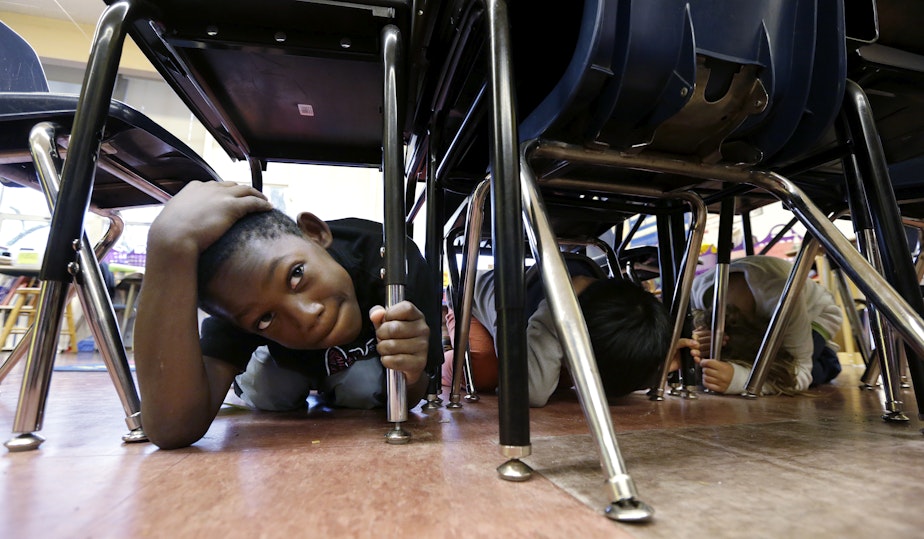These earthquake-prepped Washingtonians know exactly when the next shakeout will be

Don't be surprised if you see people suddenly dropping for cover on Thursday, Oct. 19. It's time for the next Great Shakeout earthquake drill.
The drill starts at 10:19 a.m. More than 1.2 million people in Washington state (and 52.8 million worldwide) have signed up to participate, which means they will act as if an earthquake has just struck — dropping to the ground, looking for cover, and holding on.
Those are key tactics promoted by the Great Shakeout, should a major earthquake hit the Northwest, as detailed in an informative video that has a much more upbeat vibe than an actual, terrifying earthquake.
In 2022, more than 1.3 million Washingtonians took part in the Great Shakeout.
Sponsored
Washington comes in second, after California, when it comes to be the most earthquake-threatened state in the nation. The recent 4.3 magnitude quake centered at Marrowstone Island, near Port Townsend, served as a reminder that Washington is earthquake country.
"It's not a matter of if but when," Harold Tobin with the Pacific Northwest Seismic Network told KUOW after the quake. "So all the preparation we can do from an individual level right up to all the levels of government are tremendously important."
"After a major earthquake happens, most of us would not try to leave the city immediately, unless there really were absolutely no services at all," Tobin said. "A lot of us, I think, could be faced with essentially camping in place for a little bit of time, and that's the kind of preparation I think is useful."
For those preparing for such an event, the Earthquake Country Alliance recommends taking a few actions in advance, such as preparing emergency supplies, organizing living space with an earthquake in mind, and making sure important documents are organized and in a safe place.
Sponsored
In preparation for this year's Great Shakeout, a group of West Coast earthquake experts held an "Ask Us Anything" event on Reddit, offering answers to questions and concerns. A few of the good points that emerged from that session include:
- The last "Big One" in the Cascadia Subduction Zone was around 1700, and experts estimate that such a major earthquake happens every 200-600 years. They noted that there is a 15-25% chance a magnitude 8 or higher earthquake could happen in the next 50 years.
- While a lot of folks focus on the "Big One" striking, many other earthquakes (such as the recent one in Western Washington) will continue to happen.
- While some experts said "San Andreas" was a good earthquake movie, others preferred "Shin Godzilla" when it comes to having an emergency management mentality. "Dante's Peak" was mentioned as a good film in terms of geology ("2012" was cited as having bad geology). Unfortunately, many experts had not seen "Escape from LA."
- There is no known cure for earthquakes. (KUOW's Dyer Oxley would also like to add that having Superman fly around the Earth in reverse to prevent major seismic events is also not an option.)
- The epicenter of the next major earthquake will likely be offshore (deep underground), and the level of shaking could differ throughout various areas along the West Coast. For example, Portland could experience a different intensity than Seattle, but the shaking will still be significant. The United States Geological Survey has an online map indicating where models predict major shakes could occur.
- Solid tables and desks are good places to find cover during an earthquake. Running to another room is not recommended. If you're in a car, pull over as soon as possible, set the parking break, and don't leave the car. If you're in bed, stay put and cover your head with a pillow. Here are more recommendations.
- Important things to have prepared for an earthquake at home or in a car: one gallon of water per person, per day; food; first aid kit; clothing; medical needs. More info here.
- Tall buildings built more recently (under newer building codes) are likely to do better during a major earthquake, though shaking will be felt more significantly on higher floors. Older buildings may need to be retrofitted to be earthquake ready.
- Tsunamis are possible, especially along the coastline of Washington. The Strait of Juan de Fuca and the Strait of Georgia could experience a different intensity than other parts of Puget Sound. Check out this tsunami wave simulation.


